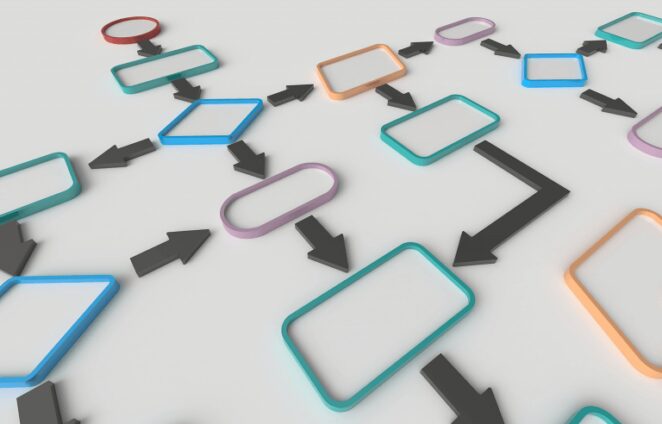A flowchart depicts the individual steps of a process in a logical order. It is a generic tool used for a broad range of purposes and can be utilized to interpret a number of procedures, including manufacturing, administrative and service processes, and project plans. It is one of the seven core quality tools and is a frequent process analysis tool.
In a flowchart, it is possible to include many types of elements. For example, they can be a sequence of events, substances, or services arriving or exiting the process and decisions that need to be formulated. In addition to that, the flowchart can also provide detail about the individuals involved, the time incorporated at each stage, and process metrics as well.
Flowcharts are also known by other names, such as process flow diagram and process flowchart. In addition to that, there are different variations in flowcharts. Some common varieties include top-down flowchart, macro flowchart, micro map, detailed flowchart, deployment flowchart, process map, symbolic flowchart, several-leveled flowchart, and many more.
As of now, there are plenty of online software and tools for creating flowcharts. If you want, you can have a look at this maker, which is one of the best online software for developing different types of flowcharts.

Explaining How Flowchart Is Beneficial In Conveying A Problem Solution
Before developing the whole computer program, one of the most common uses of a flowchart is to outline the sequence of actions and reasoning for addressing a problem. In addition to that, it also aids in the communication of the solution’s steps to others. To put it simply, a flowchart is a diagram that depicts the problem-solving process.
Here are a few ways how using a flowchart is definitely effective for problem solution communication:
- Defining the primary issue
- Helps in distinguishing between fact and opinion
- Assists in coming up with alternate options.
- It assesses alternatives that should be put off for the time being.
- Considering the accessible options and making a decision.
- Comparing and contrasting different options against a set of criteria.
- Enforcing and following up on the solution.
Creating A Problem-solving Flowchart
In general, for non-linear thinkers, a mind map is a beneficial tool. On the flip side, a flowchart may be beneficial for your problem-solving method if you are a linear thinker, meaning someone who speculates in terms of step-by-step progression. In short, a flowchart is a graphical indication of a workflow or procedure that uses different shapes attached by arrows to demonstrate each phase.
Flowcharts are ideal for solving problems and answering questions that tend to arise several times. Make sure to follow the below-listed steps to begin the problem-solving flowchart:
- In order to indicate your problem, it is best to draw a beginning shape.
- Make a choice shape with which you can ask questions with this-or-that options.
- Depending on the this-or-that answers, sketch arrows by attaching the alternative paths you can take to progress through the steps and individual procedures.
- Proceed with exploring pathways and raising questions until you find a logical answer to the challenge you have been given.
- Give the solution a try. The process is done if it works. In case it does not seem to work, go back through the flowchart to see what went wrong and rewrite it until you discover a suitable solution.

Common Types Of Flowchart Symbols Used In Flowcharts Related To Problem Solutions
Getting to know the most popular flowchart symbols and norms will make it a lot easier whether you are trying to browse or establish a flowchart. In this section, we will learn more about the four common symbols used while making the flowcharts.
Symbol 1: The Oval Shape
What It Is About: The end or beginning when developing a flowchart
The terminator, also known as oval, is used to symbolize the beginning and finish of a process. You can use the drag and drop options to select these symbols while creating a flowchart with the online software. Keep in mind to utilize the same symbol to indicate the end of your flowchart.
Symbol 2: Rectangle Shape
What It Is About: In the flowcharting process, this is a step.
Once you have begun the flowchart, the rectangle will be your go-to shape. It is the workhorse of the flowchart illustration. In addition to that, it depicts all the steps included in the process you are describing. It is better to utilize rectangle symbols to catch process steps like basic tasks or actions in your process.

Symbol 3: The Arrow Shape
What It Is About: Indicate if the flow is going in one direction or the other.
These arrow marks help people to know the direction of the diagram along with the flowchart. There are plenty of different kinds of arrow symbols to select from. One thing you have to keep in mind is that it is best to use either one or two types throughout your flowchart. It keeps the chart tidy, and it also helps you to highlight specific steps in your chart.
Symbol 3: The Diamond Shape
What It Is About: It illustrates a conclusion
The diamond represents the need to make a decision in order to go forward. It could be a simple yes-or-no decision or a more complicated decision with several options. It is best to make sure that you have included every potential option in your chart.
You probably have everything you require to create your own flowchart by using these basic four basic symbols. Keep in mind to select decent online software to develop flowcharts. There are some free tools, while others are paid tools. However, a few of them offer free trials, and you can make great use of them.

Conclusion
As you can see, the flowcharts are relatively effective in communicating a problem solution. In short, there are several benefits of using flowcharts, such as enhanced communication, high-end visual clarity, quickly identifying problems, making effective analysis, and finding the best solutions.




